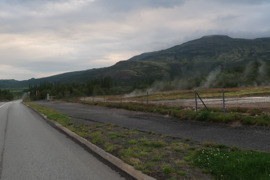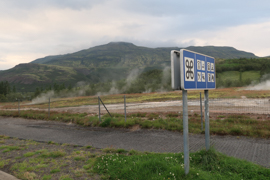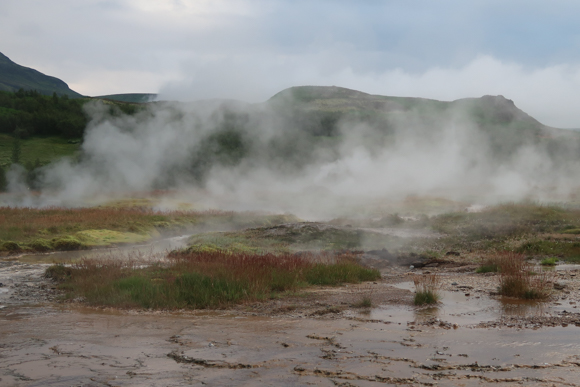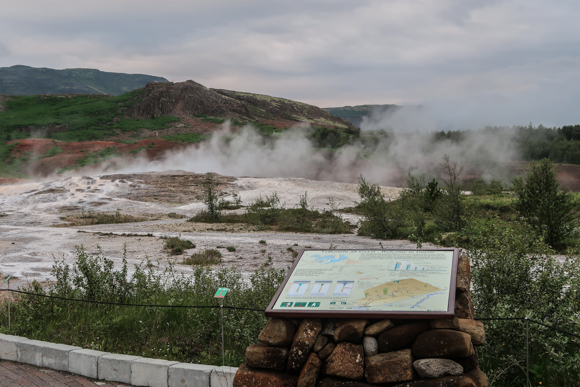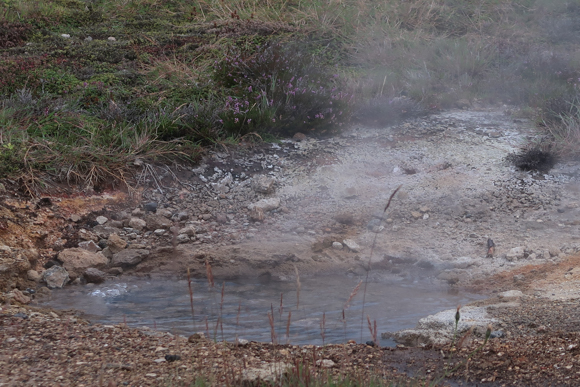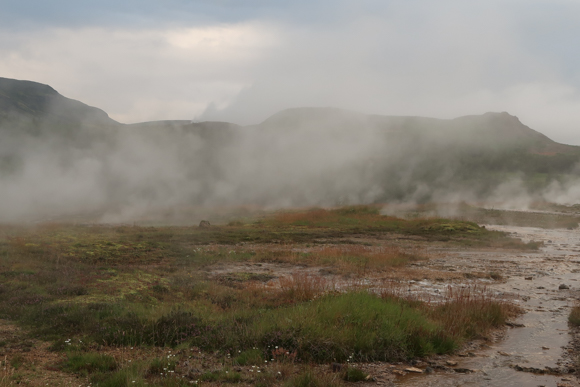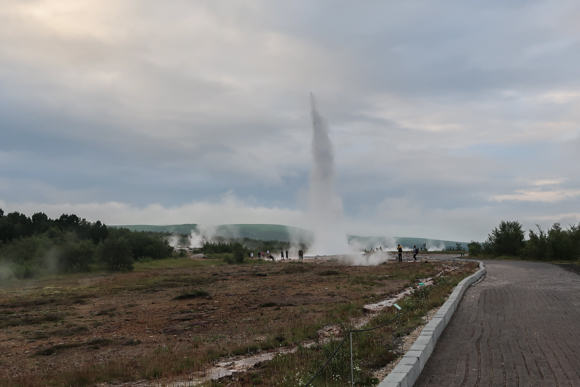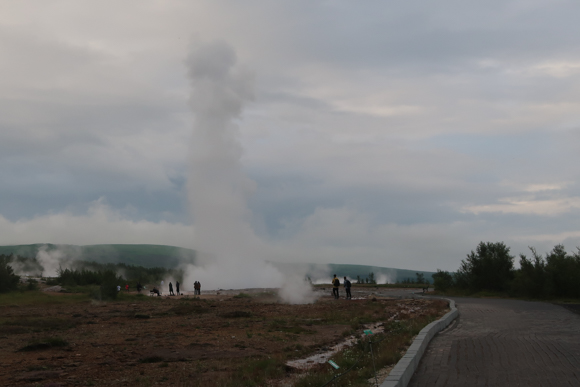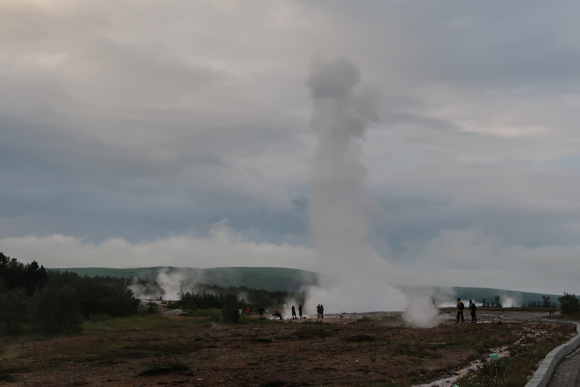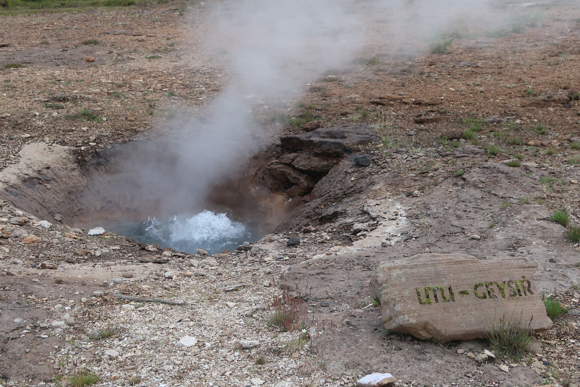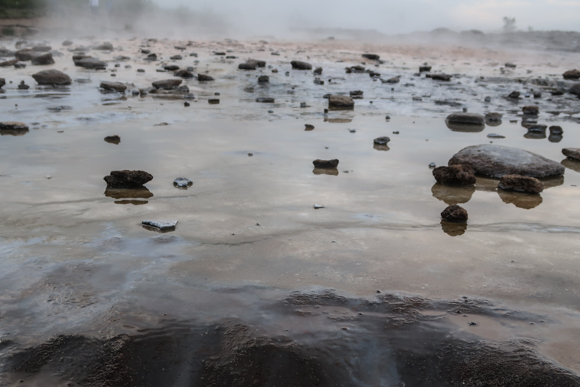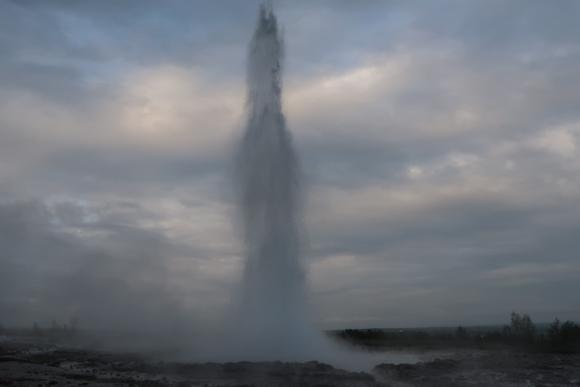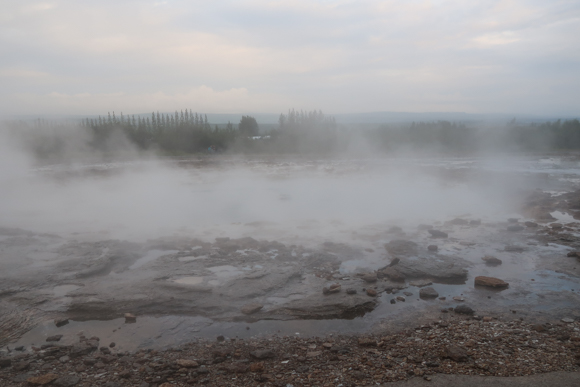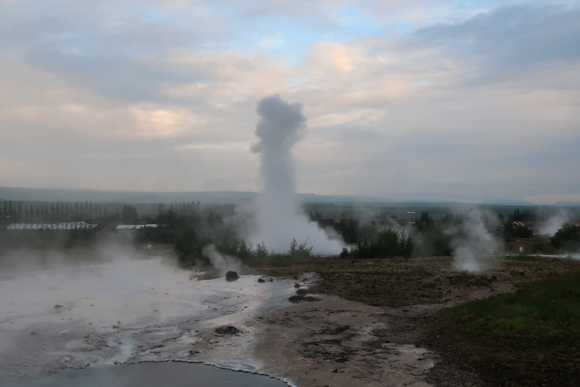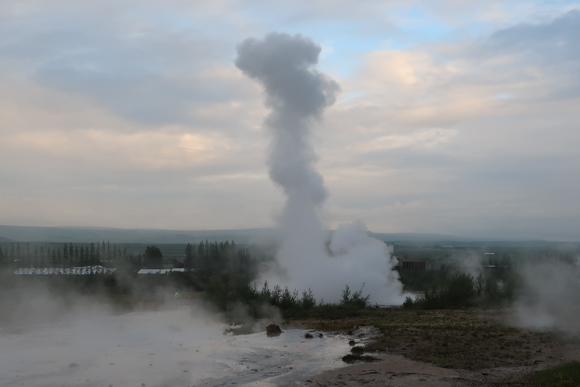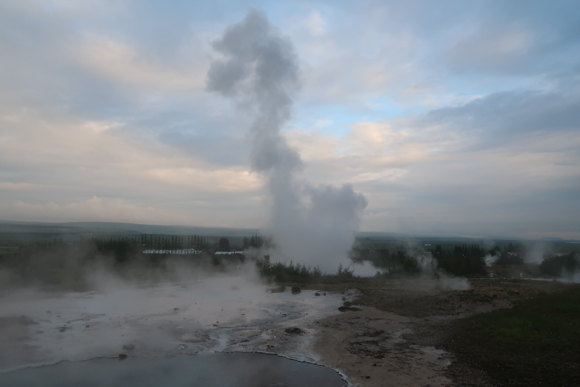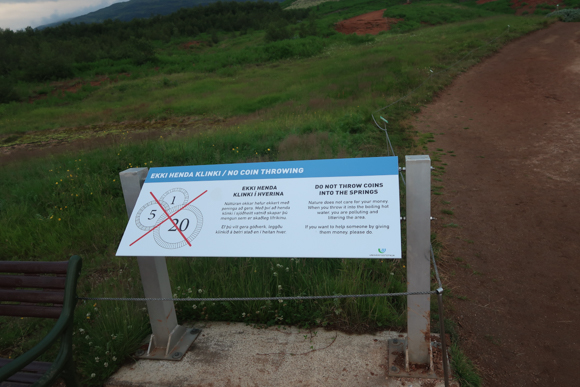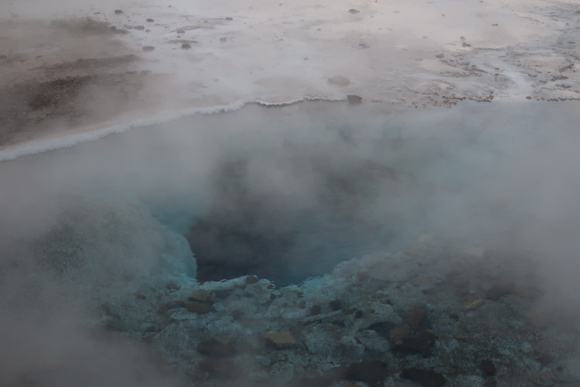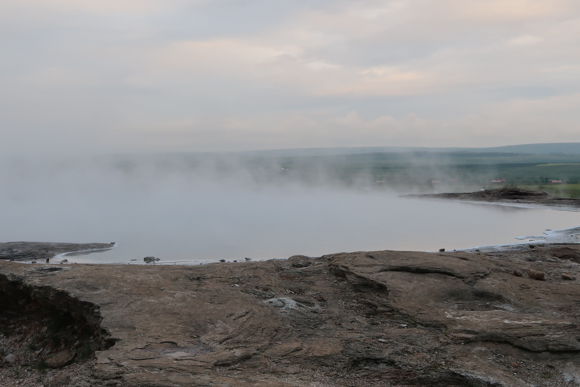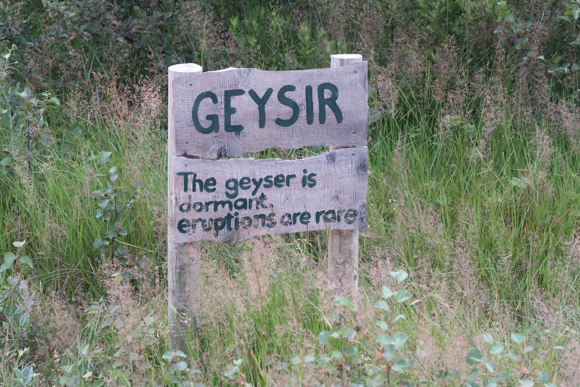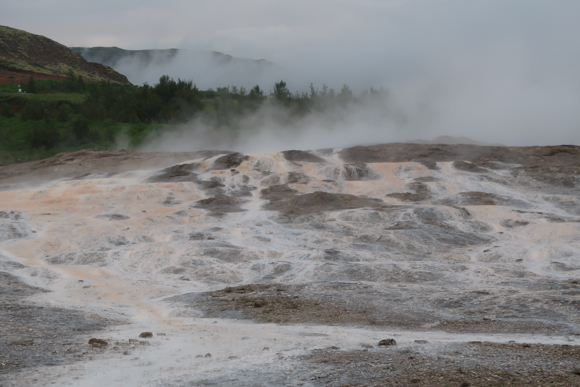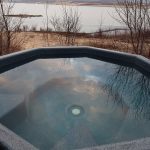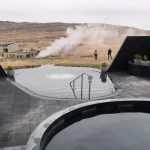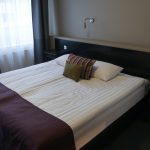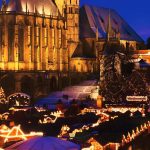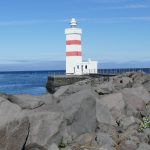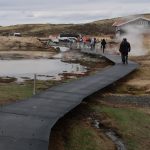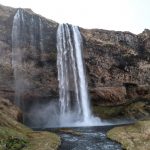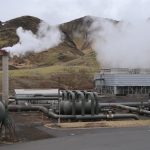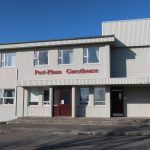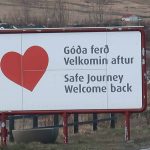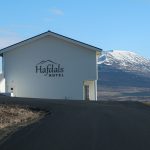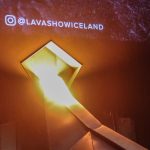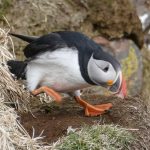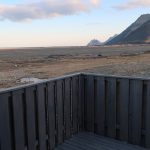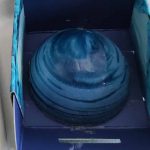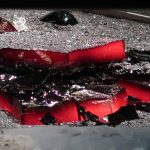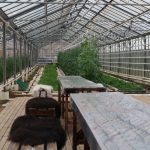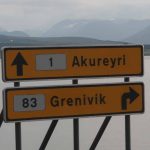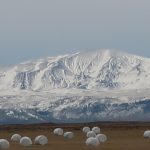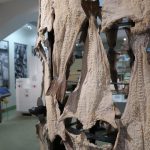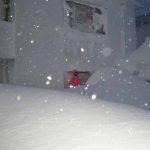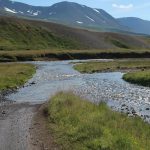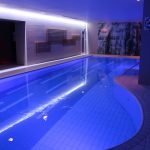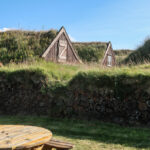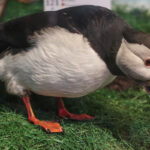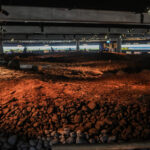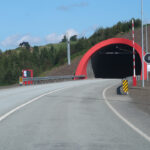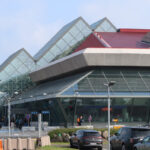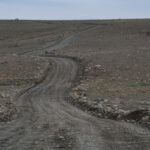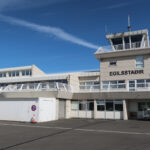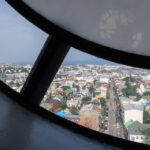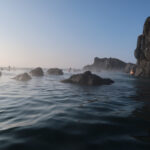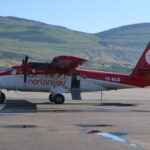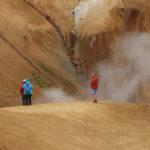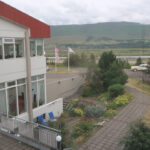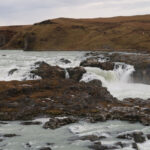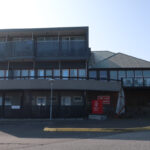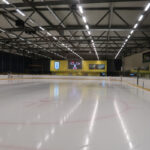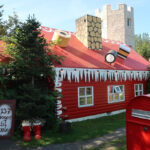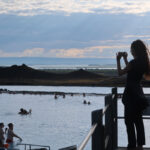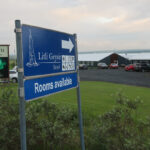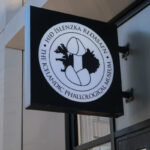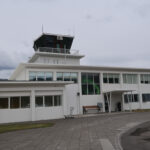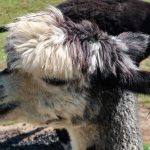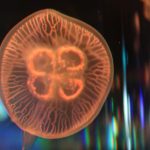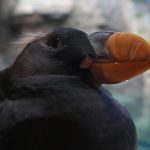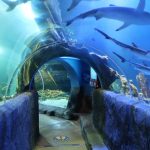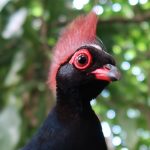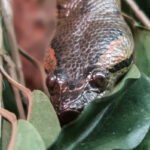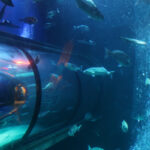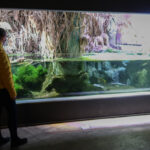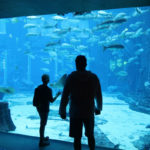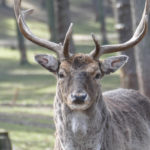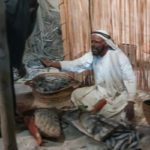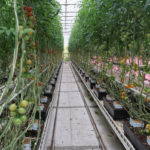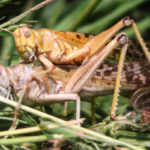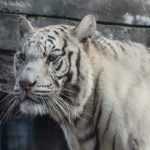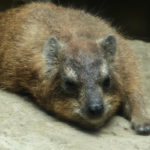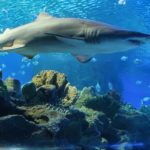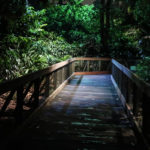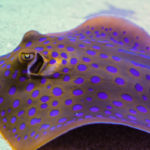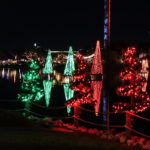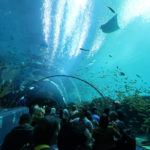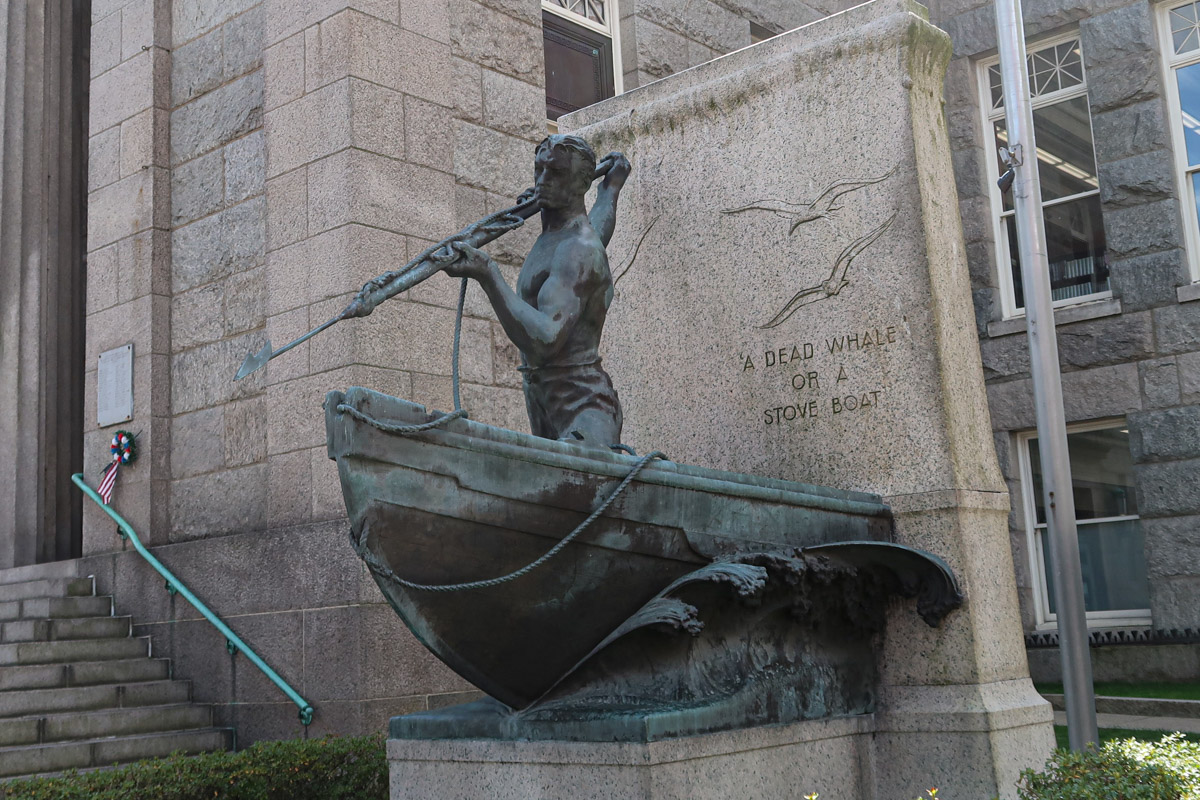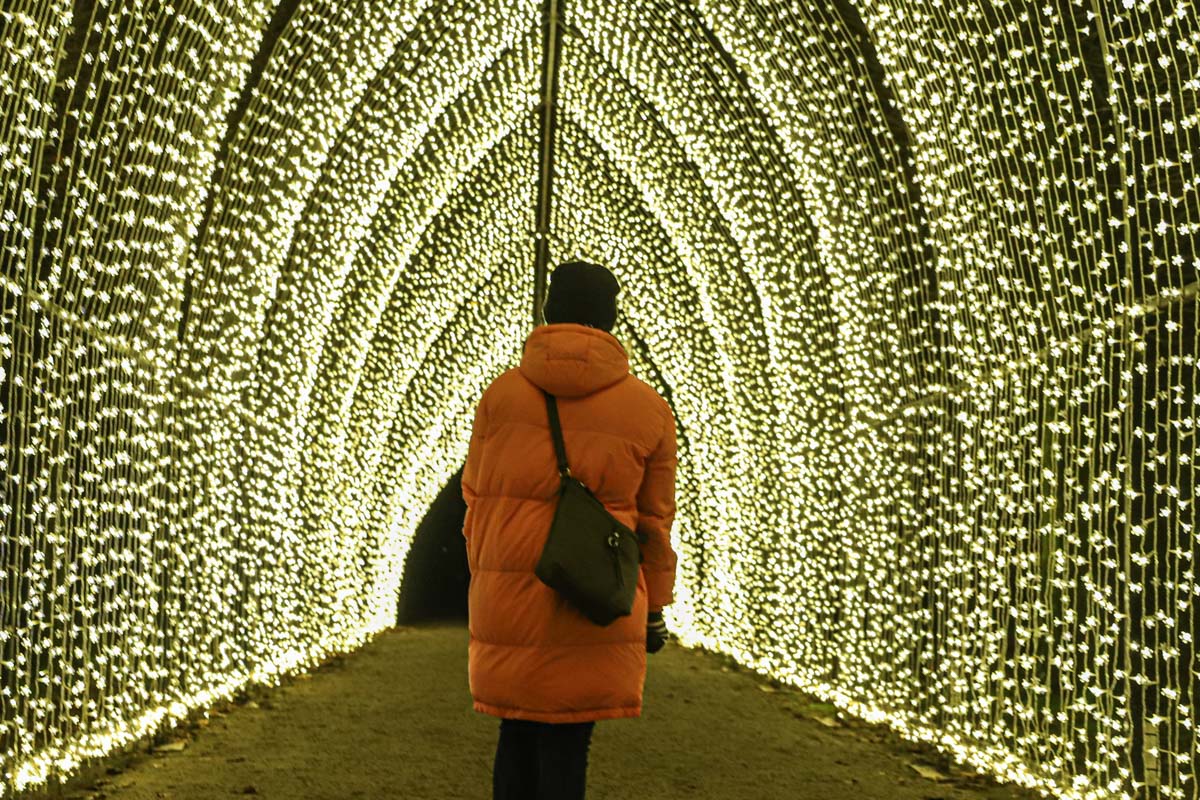What is your first thought about Iceland? I think many people associate the stunning, unique nature with the Nordic island – and especially think of hot water springs. There are places like Myvatn Geothermal Pools or the Blue Lagoon on the one hand – and the geysers on the other. The big Geysir and especially the very reliable Strokkur are a must visit for any tourist on the island – and are thus part of the “Golden Circle” Tour. With this Pictured Story, I take to hot water bubbles and fountains.
Geysir Hot Spring Area – Location and Access
The Hot Spring Area is located at route 35. The road is not a restricted road in this area – the later section of the road (F35) is at least banned for certain rental cars. The Gullfoss waterfall is not too far away from the geysers. Another quite popular attraction in the region is the lovely Laugarvatn Fontana geothermal bath.
The geyser area is open to public any time and there is no entrance. Opposite the road is a service area with a souvenir place and shop, a (card only) petrol station and two hotels, which belong together. I stayed at the Litli Geysir Hotel, which also gives you a late evening relaxed walk to this site. The service facilities are open from 10:00 to 18:00 hrs.


Pictures from Geysir Hot Spring Area
Below are some snaps from the Geysir area. Unfortunately, the weather at my visit was not ideal – if you have a clear day without clouds, you will have a better experience. The three “stars” of the grounds are the three geysers Litli Geysir (“Small Geyser”), Geysir (“Geyser”, also “Large Geysir”) and especially Strokkur, which means “Butter Barrel”. The small geyser is really small. Its giant brother is very impressive, but you need a lot of luck to see the eruption. It may reach heights of up to one hundred meters. However, the eruptions happen rather rarely. Strokkur is Mr Reliable in the geyser world. The water is shot upwards to up to around thirty meters above soil. The time between two eruptions is roughly every ten minutes, which turns it to a massive tourist attraction – eruption sighting is practically guaranteed.









Due to the reliability of Strokkur, you typically already see the first eruptions while you walk along the footpath from the parking lot to the geysers. On that route, you pass along small thermal springs. You can watch the geysers from different angles. You typically meet the large geyser last on your trip. Using soap or washing power to attract the geyser, which has been done in earlier decades, is by the way strictly illegal nowadays. As you typically watch a couple of Strokkur eruptions while being around and have a look into the visitors’ center, I would at least suggest to block some 60 to 90 minutes for your time at the geysers. If possible, try to avoid the later morning to early afternoon hours, when bus tours flood the area.

















Flyctory.com and Iceland
Here are all my postings related to Iceland:

The Breidamerkurjökull Glacier in the Southeast of Iceland forms the Jokulsarlon, a Glacier Lagoon. The major and smaller iceberg being ...

It's Saturday again, time for another look into new songs. My week this time is somewhere between tennis excitement and ...

I am just sitting at the American Express Centurion Lounge in Heathrow (LHR), ready to head to the United States ...

Managing my backlog of possible reviews sometimes leads to some rather late reviews. This posting is my last hotel review ...

I had the idea to this post when I sat in the American Airlines Admirals Club at Pittsburgh Airport (PIT), ...

I hate when I simply don't make it to fit in reviews in time. This review, for example, is based ...

I'm in Finland this week, featuring two floorball match. However, the Nordic country is not represented in my Songs of the ...

While quite a lot of traveling is ahead of me during the next weeks, November and December 2024 was rather ...

Iceland is among my favorite travel spots in the world. I am also very fascinated by the Icelandic music scene ...

Hungary this weekend! After my trip to Indonesia, I am back in Hungary after such a long time of absence ...

The pictures already suggest it: this hotel review is in fact not based on a recent stay. My wife and ...

After my first posting about the debut event of the 3x3 World Floorball Championships was about the first day of ...

Despite the World Floorball Championships coverage, I of course want to keep my Songs of the Week updated. Due to the ...

Husavik used to be one of the key whaling spots in Iceland. Nowadays, the city is still famous for the ...

I struggled a bit compiling the Songs of the Week this time. The partial flight miles for my current trip ...

The last geothermal spa my wife and I visited on our tour through Iceland in May 2023 was Krauma. Compared ...

This week, I am dealing with quite a lot of music postings during the week. There are two reasons for ...

Reykjavik has been the last stop (before staying at the Aurora Star at Keflavik Airport KEF) of the Icelandic Ring ...

It's time to look back to . After I shared my new format My Year in Travel with you the first time, ...

Unfortunately, I could not complete the Country Christmas Playlist this year due to technical issues. However, since the days become ...

Oh, Christmas is approaching quickly now. A huge number of songs I scanned for my Songs of the Week this time ...

The recent seismic and volcanic actions on the Reykjanes peninsula really touch me. Dung the last years, Iceland has more ...

About the album Early Warning, the Icelandic artist Myrkvi states on his website, It represents a conclusion to the duo’s past and ...

I recently introduced you to the Geothermal Exhibition at the Hellisheidi Power Plant. Due to the high geophysical activity in ...

The are numerous and spectacular waterfalls in Iceland, spread all over the island. However, the Seljalandsfoss is one of the ...

It is well-known to most visitors of Iceland that the Nordic island produces a vast majority of their energy with ...

The Icelandic artist Arny Margret is truly a musician I enjoy following with Flyctory.com. On 22nd September, she is releasing ...

Indie-folk, classic sound or pop music? It is hard to categorize any mind of music into categories. Without a doubt, ...

Husavik - as you recently have learned, the small town in North Iceland is one of my most favorite spots ...

Even though I am German, I am not an overwhelming soccer (or, for major parts of the world: football) fan ...

Reykjavik and the surrounding cities are the core of Iceland. Even though the area does rather feel like other Nordic ...

Sometimes, I Made An Album is named the English language debut album of Dadi Freyr (who is correctly spelled Daði Freyr) ...

Home is where the heart is - I had the idea to this posting about my favorite cities of the ...

Our Ring Road Trip through Iceland in April and May 2023 took us to three geothermal spas. I already introduced ...

Sometimes, you just need to learn where your steak - or your Icelandic sweater is originally coming from. What is ...

After I introduced you to the Boeing 757-200 Saga Premium Class, the premium product of Icelandair, in 2021, I felt ...

The first night in Iceland or the last night before going back home - that's about the time when quite ...

Newcomers and established artists, rock and schlager, party songs and deep messages - I feel that this edition of my ...

There are a bunch of iconic dishes in Iceland. One which made it globally is Skyr. Isey, one of the ...

Akureyri in Northern Iceland is my favorite city of the island. Also as I expected to be there just the ...

Husavik is not only known due to the Fire Saga Eurovision movie on Netflix, but is more than that one of the ...

Traveling out of nowehere: I compiled this set of songs in Swansea in Whales, watching the very last Rock of ...

The black lava beaches of Iceland are one of the must visits to many tourists. One of the most well-known ...

Minor and major volcanic eruptions happen regularly in Iceland. People pay a lot of money for helicopter trips or do ...

Puffins are one of my favorite animals. Thus, being able to say hello to them in wildlife conditions is always ...

During our 2023 Ring Road Trip through Iceland, we had a wide range of stays: from guesthouses to hotel chain ...

I have struggled quite much with health issues this week - which also prevented me to travel to some British Rock ...

Iceland is definitely one of the countries I love to travel to most. The unique nature, a very interesting culture ...

Our April and May 2023 trip along the Icelandic Ring Road had also been dedicated to visiting some of the ...

Oops, I did it again. Just within about a month, I feel that I had a nice volume of flights, ...

On the week at which I am publishing this review, many people are focusing on Liverpool. They look forward to ...

Eight days of traveling along the Icelandic Ring Road are done. The trip was just intense. My wife and I ...

Last full day in Iceland. We decided not to start too late (also because the car had to be moved ...

The circle is closed on Day 7 - we are back in Reykjavik, where the trip more or less started ...

Day 6 on your Iceland Ring Road trip - time to start counting down the kilometers towards Reykjavik and Keflavik ...

We arrived significantly later than expected in Husavik on Day 4, so that Day 5 was packed with Husavik action ...

With the weather being much colder than expected, we had to alter our travel plans for the Iceland Ring Road ...

After the intense travel at Day 2 of our Iceland Ring Road trip, Day 3 was thought to be a ...

After arriving in Iceland the day before, Sunday 30th April 2023 was thought to be the most intense travel day ...

Let's take you on a trip to Iceland. This is the first proper entry to my Trip Report, which takes on ...

Traveling on the Icelandic Ring road or Road 1 is one of the "classic" trips you can do on the ...

As I am having some quite intense travels ahead of me, I currently try to prepare as much contents for ...

After some rather intense traveling, I am glad that there is just a short trip this week. I concentrated on ...

Damn, it is already four years... And it is more than 2,750 postings since then. On 25th February 2018, I ...

In this Pictured Story, I want to take you on a road trip in Iceland which I in fact already ...

The fishing industry has been (and still is) an important part of the Icelandic economy. The Reykjavik Maritime Museum is ...

Even though all my visits to the area have been pre-Flyctory.com, Isafjordur and the West Fjords are belong my favorite ...

Since I ran into her song akureyri in my Songs of the Week feature as of 28th January 2022, I really loved to listen ...

Many tourist traveling to Iceland put the day trip of the Golden Circle on the top of their list. Apart from ...

If you follow Flyctory.com for a while, you know that I love the Northern Icelandic city of Akureyri. This posting ...

This review is about music from Iceland. I am always happy to run into music from one of my most ...

Despite the country as such is rather small (measured by the number of people, not by area), Iceland has some ...

It's summer season in Iceland right now again. People explore the amazing highlands. While I still struggle to complete a ...

Flugsafn Islands - or the Icelandic Aviation Museum - has of course been a attraction I just could not miss while ...

Icelandair Domestic, Air Iceland Connect or Flygfelag Islands - the inter-Iceland aviation connections nowadays driven by Icelandair have different historic ...

Okay, this week, my Songs Of The Week listeners need to stay strong: I started my list with schlager (with a touch ...

During one of my trips to Iceland in 2021, I decided to have two nights right at Reykjavik Domestic Airport ...

Akureyrarkirkja or simply the Akureyri Church is one of the key eyecatchers of the Northern Icelandic city. The Lutheran church, ...

The Vestmannaeyjar islands and especially Heimaey, the main island of the "West Men Islands", are a key tourist attraction of ...

There are a few Turf House Museums you can visit in Iceland. The UNESCO is even thinking about putting this ...

Apart from the legendary Blue Lagoon, the Viking World / Vikingheimar in Nardvik on Reykjanes is likely one of the most ...

As some of my plans during my stay at Vestmannaeyjar did not work out as expected, I had time to ...

The Settlement Exhibition Reykjavik (sometimes also with an added ± 871) gives you an insight of the 10th century settlement ...

While whaling has been quite popular in Iceland's past, the large marine mammals are nowadays rather the stars on a ...

Going from Northern Iceland's largest city to the famous Myvatn Thermal Bath or even further on to Egilsstadir - the ...

There is currently some effort to establish regular international flights from Akureyri (AEY) again, but in general, if you approach ...

The F35 - or Kjölur Route is likely the most famous road trip in Iceland, apart from route 1, the Ring ...

After I ran into her song akureyri and made it head one of my Songs Of The Week episodes, I was really looking ...

Iceland is indeed a country, which is famous for its broad music culture. There are several Icelandic acts, which became ...

When I visited Iceland in October 2021, my Lufthansa flight from Munich Airport (MUC) to Keflavik (KEF) arrived at the ...

Icelandair gave me a very short-term cancellation for my flight to Vestmannaeyear, when I visited the island. However, I definitely ...

After I have already been struggling with the idea of the Songs of the Week, the feedback on my previous edition ...

The unique architecture, the significant height of 75 meters and its location on top of the hill right in the ...

When I visited the harbor-area attractions in Reykjavik, I felt it is a good opportunity to share as many of ...

You can almost read the popularity of Iceland as a tourist destination also for North American tourists that the capital ...

Flying from Reykjavik Domestic Airport (RKV) was thought to be one of the highlights of my trip to Iceland in ...

It is time for the final posting of the years, simply named The Best Ones 2021. After looking into my ...

I so far did not have too many opportunities to cross the Polar Circle in my life. A few years ...

I did a couple of interesting road trips in Iceland during my summer stay in August 2021. Even though I ...

Especially due to a scheduled flight with Norlandair, I looked for a stay not too far away from Akureyri Airport ...

While nature lovers, highland road freaks and horse riders roll over Iceland in summer, the key attraction in fall and ...

Lava and volcanic eruptions are a regular part of life on Iceland. In 2010, for example, the Eyjafjallajökull slowed down ...

In October 2021, on a flight from Munich (MUC) to Keflavik Airport (KEF), I decided to go for a new ...

For my October 2021 trip to Iceland, I went for a car rental provider which I had used before for ...

On my summer 2021 trip to Iceland, I had the last night before heading into Greater Reykjavik in Akranes. Hotel ...

Seljalandsfoss, Skogafoss or Gullfoss - Iceland is full of very famous waterfalls. Urridafoss (which translates to "Sea Trout Waterfall") is ...

As my August trip to Iceland was prolonged by one night, as my Icelandair business class flight to Frankfurt was ...

What do Icelandic people do if there is a public toilet in the heart of their capital, which they don't ...

Apart from visiting the elite ice hockey league match of Fjölnir during my October 2021 trip to Iceland, I also ...

Relative to their population, Iceland is the sixth biggest ice hockey nation in the world. Out of 100,000 people, some ...

Covid-19 lead to numerous flight cancellations and rebookings. One of them was that I finally ended up flying back from ...

Hverir is one of the most popular geothermal areas in Northern Iceland. Two the key drivers is obviously that it ...

Summer feels to be over - Fall 2021 is coming. Finally, I had much more - and better - trips ...

We all know that Santa Claus is living in Rovaniemi, Finland... Or is he home to Russia? Northern Canada? There ...

Having a swim in a (somehow) natural geothermal pool in Iceland feels to be the equivalent to the Blue Lagoon ...

After so many other options failed, I opted to extend the coverage on Flyctory.com to the wonderful island of Iceland ...

What is the shortest flight time between Canada and the European Union? Can you walk from the USA to Russia? ...

Friday, the 13th... On 13th August 2021, I was scheduled to have my very first Boeing 737-MAX flight. Icelandair from ...

The first overnight during my August 2021 trip to Iceland was right next to one of the most iconic places ...

Half of us got one - and most of them love it/him. The philosopher Nietzsche even defined a penis envy ...

In August 2021, I finally visited a place which has been hidden from me for so long. I had so ...

In Iceland, Akureyri is called the Capital Of The North. Excluding the Reykjavik Metropolitan Area, it is the largest city on ...

I would say that at the time of writing (August 2021), Sky Lagoon is something like the hottest product in ...

Iceland - one of the most painful experiences this year for me. I already had booked a trip to the ...
Flyctory.com about Animal Parks & Zoos
Here are all postings of the Zoos and More category:

In early August 2025, my wife and I made a quick Sunday excursion. As we wanted to make use of ...

The United Arab Emirates are developing that rapidly - any time you go there, there is something new (or something ...

The South Carolina beach town Myrtle Beach hosts numerous attractions driven by the Canadian Ripley Entertainment company. Maybe the largest ...

I already took you to the American Dream in New Jersey twice. The iconic and very modern shopping mall features ...

Having a nice walk in the (somewhat) nature and meeting some animals out there - the weather was just too ...

My wife is a huge fan of zoos and animal parks. Thus, when we visited the Norwegian city of Bergen ...

During my last visit to Luxembourg, my wife and I visited the Grevenmacher Butterfly Garden - or Jardin des Papillons, ...

Japanese culture sometimes feels very different from Central European one. Thus, I loved to be in Tokyo in September 2023 ...

Blackpool is indeed an entertainment city. In summer, people are crowding the place and enjoying all the beach attractions as ...

After my recent experience with the Christmas celebrations at SeaWorld San Diego were rather disappointing, I felt to give the ...

There are a lot of zoos and animal parks in the Rheinland and Ruhrgebiet region of Germany. The TerraZoo in ...

Is it really New Year's Eve already again? The last day of the year? I am posting this one in ...

It felt so good being back at the Faroe Islands in September 2023. Even though I just had some limited ...

Being in Japan the first time in October 2023, I also explored some of the rather non-European ways to spend ...

While I was visiting the beautiful Trafford Palazzo shopping mall in Manchester, I also had a look into one of ...

Reykjavik and the surrounding cities are the core of Iceland. Even though the area does rather feel like other Nordic ...

Sometimes, you just need to learn where your steak - or your Icelandic sweater is originally coming from. What is ...

I just have a too large backlog of travel postings. Finally, it is already more than a year ago since ...

My visit at the Sea Life in Munich has still been under Covid-19 regulations. However, I feel that most of ...

essAl Noor Island is located right inside Khalid Lake in Sharjah, which is also around the Al Montazah Parks amusement ...

In April 2023, my wife and I spent three nights in Dubrovnik. The Old Town of the southern Croatian city ...

Duisburg in the Ruhrgebiet might not be on the top of your list when you plan a trip though Germany ...

Sea Life runs several outlets in Germany. One of them is in Oberhausen in the Ruhrgebiet region. With 5000 inhabitants ...

In general I feel that the East Coast of the United Arab Emirates has a lot more potential for visitors ...

Apart from the Tropicario and SeaLife, my wife and I also visited Korkeasaari Zoo in Helsinki. The main animal park ...

My wife loves almost any kind of animal. Thus, your trip to Helsinki in April 2022 finally lead us to ...

After he failed with a franchise of confectionary stores, Austrian Josef Zotter decided to go into the chocolate business in ...

Even though the city is not overwhelmingly large, Solingen in fact comes with two zoos / animal parks. While I ...

As I purchased a Merlin Entertainment annual ticket for Germany in May 2021 (majorly as I have been covering Heide ...

During one of my most recent trips to Milan, I decided to go for a couple of museums driven by ...

Right in the Sharjah desert, there is a very interesting place to learn about the regional wildlife and natural history ...

The Aquarium is one of the attractions of Wilhelmshaven. During a visit in summer 2021 under Covid-19 conditions, I visited ...

The Nationalpark Wattenmeer (Wadden Sea Conservation Area) is one of the most popular natural reserves in Germany. However, many young seals ...

The beach resort of The Hague / Den Haag, Scheveningen, is one of the most popular beach areas in the Netherlands ...

I already introduced you to the Sharjah Maritime Museum in a previous posting. Right next to this place, there is ...

Even though Solingen is not a that major city (some 160,000 inhabitants), it features two mid-size animal parks / zoos ...

I never have been to the Atlantis The Palm in Dubai as a hotel guest - but, of course, it ...

As the reviews of the park were pretty good, my wife and I headed to a deer park / wildlife ...

Abu Dhabi Khalifa Park is one of those hidden gems which you typically don't find in travel guides (or at ...

Right next to Waterloo Station, the Merlin Entertainments Ltd. drives quite a bunch of places for the London tourist heart ...

The history of Emsflower started as Kwekerij Kuipers founded by Jan Kuipers in De Lutte in the Netherlands. Not too far ...

A zoo which is suitable for the cold and rainy days as well: as you might guess already, Aquazoo Löbbecke ...

What the Loro Parque is to Tenerife is Cocodrilo Park to Gran Canaria / Grand Canary. Even though you cannot ...

Singapore is not only well-known for Sentosa or the Marina Bay Sands. The city state is also home of several ...

Due to the uncertain travel situation, there are still some reviews, which I haven't published for a too long time ...

The Smithsonian's are just a tourist's (and likely also a resident's) best friend when visiting Washington DC. The US capital ...

During my Covid-19 day trip to Berlin, I spent some time in the Berlin Zoo. Berlin is quite famous for ...

It is very hard to really describe The Green Planet in Dubai. It is something like a compact and artificial rain ...

When you think about Zoos and similar parks on Tenerife, you of course think about the Loro Parque, which is ...

The S.E.A. Aquarium is one of Singapore's key tourist attractions and likely the people magnet on Sentosa Island apart from ...

During my March 2019 stay in Oxford, I also had the chance to explore at least some sights of the ...

Singapore River Safari is one of four Wildlife Reserve Singapore Parks offering differently themed animal parks. Thereby, River Safari is ...

Right next to Petronas Towers and the lovely KLCC park, the Kuala Lumpur Convention City also hosts an aquarium in ...

Nowadays, you like have zoos in every major city of the world. If you are not a lion fetishist, you ...

Florida is full of amazing water attractions and aquariums. Installing a Sea Life in the limited space of the ICON ...

The Tampa Bay area is full of top attractions for animal lovers. After we visited Busch Gardens, we decided to ...

You want to spent a day with family or friends and cannot decide whether you want to go for the ...

When you think about a great Christmas time in one of the Orlando theme parks, you likely first think about ...

There are quite a lot of minor deer and animal parks around Cologne, quite a lot of them mainly based ...

Located North of Cologne, the "Wildpark Tannenbusch" offers a nice way to spent your free time with your family, enjoying ...

The Ripley's Believe it or not Museums are quite well known. As I never visited one so far, I was even ...

Just having started as an "ordinary" farm at the edge of Willemstad, the Curacao Ostrich Farm is now one of ...

It is Atlanta's finest attraction, regarding Tripadvisor. Just across the park from "World of Coca Cola", Georgia Aquarium is home ...
